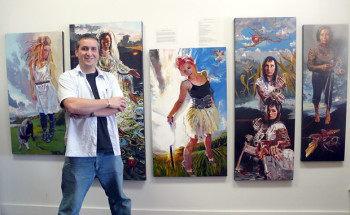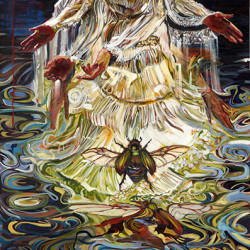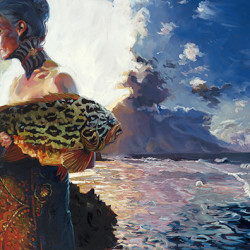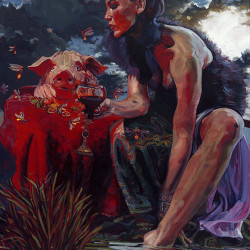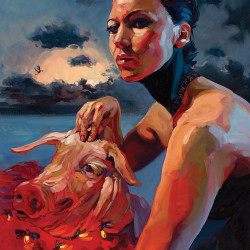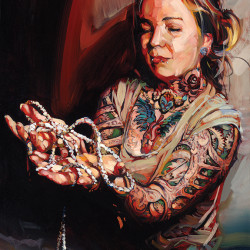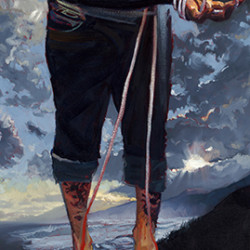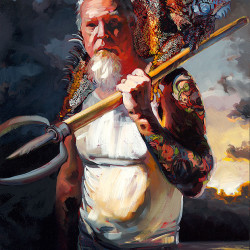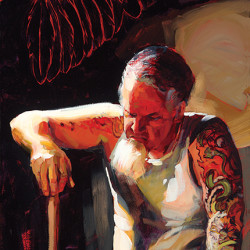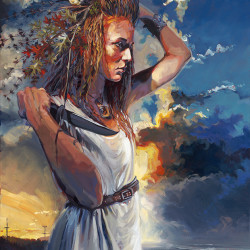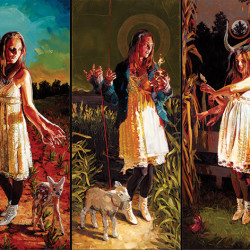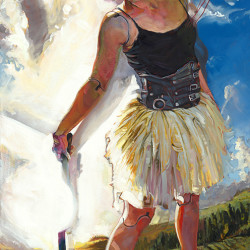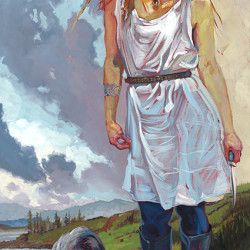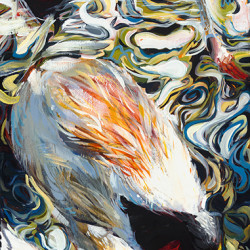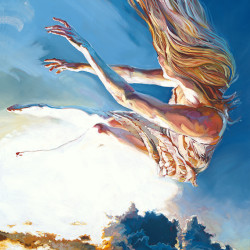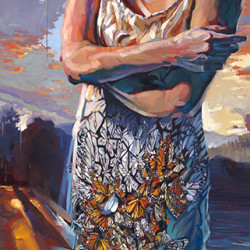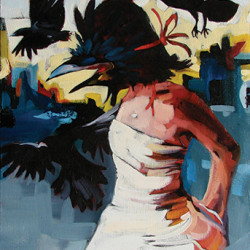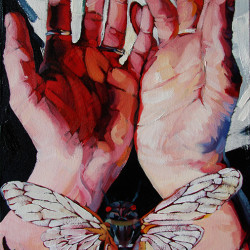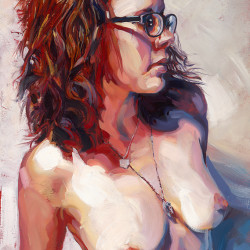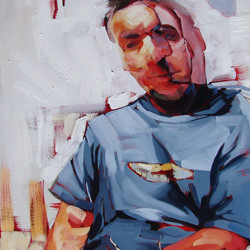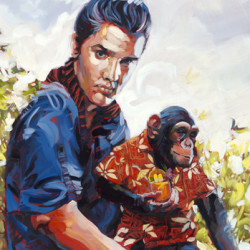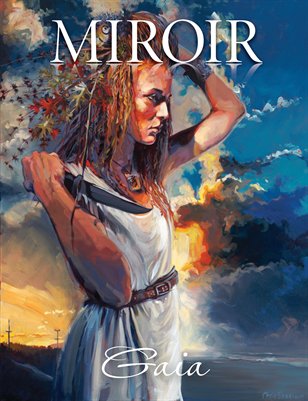Storytelling is actually the core element of my art — the foundation upon which my paintings are built. I’m intrigued by early myths, traditional folklore, the histories, and the classics. Each painting I make explores one of these things, and every element in my compositions has symbolic meaning that supports that story.— Chris Sheridan
Q: Tell me something about your history in the creative arts. Did you have a formal school education or are you self taught?
A: I went “all in” pretty young. By the end of high school I had already studied set building/painting, traditional animation, character design, special effects make-up and sculpture, drawing, and randomly enough, stilt walking. Going to art school was a bygone conclusion, and I received a BFA in Illustration from the Ringling College of Art and Design. I spent summers building theater sets, apprenticing with a traditional sign painter, and creating parade floats for Warner Brothers and the Disney College Alumni Association. After graduating from Ringling, however, I floundered a little; then one night while sitting at a bar, a commercial for the Academy of Art University came on the television, and my friends bet me $500 that I couldn’t get in. As a result of that bet, I received an MFA in Painting from the Academy, rediscovered my drive, and the rest is history.
Q: What were the circumstances that planted that first creative spark in you, and how is that tied to your current inspirations?
A: My mom is certainly a creative soul, and she was relentless in her support of me drawing killer whales and aircraft carriers as a wee little kid. When I think back, though, the most singular “spark” was in 7th grade. It was our first major book report project: we had to read a book, break down the plot and characters, and spruce up our writing with quotes. Somehow I found the nerve to ask if I could draw my report; harsh glare from the teacher, sweat on my brow…“okay.” Score! I then proceed to choose the longest book in existence, Tom Clancy’s Red Storm Rising. That book might as well been War and Peace (ironic), but it had guns, battle ships, nukes, and kicking the crap out of the Soviets to boot (keep in mind this was the 80’s). I illustrated the whole thing in crayon, 50+ pages, with enough quotes to keep the teacher happy. All these years later, I’m still drawn to researching myths and literature, although I pick much better sources now.
Q: How has your creative nature influenced your personal relationships?
A: My nature compels me to surround myself with kick-ass people. I am forever indebted to the amazing creative individuals that surround me every day. I am lucky to have a network of close friends that spans the globe, but I’ll focus on Seattle for this answer. We have an incredible “Art Family” here: we come from many walks of life, we’re all extremely passionate about what we do and we don’t always agree, but we always have each other’s back. Everyone is talented, and can be really serious, but we also laugh a lot and stumble upon epic adventures. As hard as things get, I keep going because of them, and I don’t want to let them down — I know that if I slack off, they’ll let me have it. We have an amazing bond; hell, I’m engaged to one of them now. And no, Kate and I have not set a date; we’ll probably put it off until the last minute and pull some kick-ass event out from that magic place artists draw from so often.
Q: Can you say something about your use of storytelling, and its role in your work?
A: Storytelling is actually the core element of my art—the foundation upon which my paintings are built. I’m intrigued by early myths, traditional folklore, the histories, and the classics. Each painting I make explores one of these things, and every element in my compositions has symbolic meaning that supports that story.
I believe that storytelling is one of the basic principles that has shaped who we are, and has helped us on some level to understand the human condition. Stories haven’t always been so dry, superficial, and easy to consume (my problem with most literature and movies today); there was a time when they challenged us, and forced us to think by not supplying all the answers. In some way, I’m searching for the root of our beliefs, the origins of our religions, our political views, and the events that created our current world view. Perhaps most importantly, I’m fascinated by how many of the basic building blocks of our society have been forgotten or changed to a point beyond recognition. Looking to the past is my attempt at understanding us, and certainly has become a path to understanding myself.
Q: How does personal intuition play a part in your life’s work?
A: My intuition helps me find links between stories I’ve read and people and places I know, which leads to the visual “stories” that I tell. The models I use in my paintings are not random choices: each one has a life story or personality trait that matches something in the story that I’m researching, and sometimes that connection is a surprise even to me at first. For example: I was researching ancient oak fire rituals and the use of oracles who spoke directly with the gods via the smoke and foretold the future, and to this day I don’t know why, but it made me think of a friend of mine. I didn’t know all that much about her, and she had never modeled before, but when we began talking about the premise for the piece her eyes lit up, and she asked me if I had known that she was brought up in a southern church that practiced in “speaking in tongues directly with god.” I hadn’t, but that strange, fortuitous connection still excites me all these years later.
Intuition helps me technically as well. If there’s one thing a Master’s degree in painting is good for, it’s filling your head with an abundance of theories, techniques, and art historical references that are at times integral to your body of work, and at other times, a completely debilitating mind fuck that stymies your every brushstroke. I research early ritual, religions, mythology, and folklore, combine plot and symbolism with contemporary figures and, for an added layer of depth, place the figure in an emotionally charged landscape. I shoot my models almost exclusively in my studio, so creating a believable painting involves a lot of color theory and form manipulation to match perspectives. My degree often whispers to me how things “should” appear, but the solution can become garbled when I try too hard. That’s when intuition steps in and saves me. Some people call it the zone: it’s that moment when you let go and the real magic happens, where nothings else matters. Before I know it, a lot of the “rules” in my head have been broken, but for whatever reason, it all makes sense. You’ll often hear me say that a painting was a battle; more often than not, it’s a painting where my head tried to keep me from letting intuition in.
Q: What is your idea of success, and what are your goals for the future, what would you wish to accomplish in your lifetime?
A: I could try and sugar coat this one, but let’s get into it. Success comes in many flavors. I’ve worked hard to build a solid name for myself as a painter over the last decade. I’ve won awards, I’ve shown globally, and I’ve been included in some respectable publications. But have I sold out a show at a blue chip gallery? Have I been included in any art history books? Most importantly, am I still learning? My current definition of success is to be the best I can be, and leave a lasting impression.
That last part—learning—will always be a critical element of success for me, and keeps me going from day to day. We all need to keep learning and growing. Always. Ask anyone that knows me, and they’ll have heard me say “you have to keep yourself on your toes.” An artist’s worst enemy is complacency; complacency leads to stagnation. I fight my paintings, and I try to make them as hard as possible to complete; in this way, I will forever continue to grow.
As for a lasting impression, I may not have sold out a show at that blue chip gallery yet, but people recognize my work, my style and my name. At a show in a top Seattle gallery recently, one of the featured artists said I was one of his early influences (which was an incredible feeling). A few months ago, my nephew wrote to me to let me know that his art teacher in New Hampshire used my work as an example in his class. These are signs of success, I think, but I still have this burning deep inside for more. My lifetime goal? For my art to be remembered.
Q: How do you feel about the theme Gaia and what is your feeling about the artist’s role in protecting the earth or making the public aware of related issues regarding nature, sustainability, endangered environments and species?
A: This is a really big question.
I lean towards polytheistic thinking, and I often thank the gods for all that they have bestowed upon us, and me. A lot of my work makes references to these beliefs, but as I think about it, Gaia (Terra, if you lean towards the Romans) hasn’t been explored in depth in my work yet.
You may notice that there is almost always a conflicting spotlight, creating a double light source in my work. The second light source is my version of the god light: the divine hand conducting our collective consciousness, and the complex connection that binds even the most trivial things together. I believe that connection, that balance, is integral to our existence. The Gaia Hypothesis suggests the theory that all life is connected, not only among each living thing but also with inorganic material, creating a complex, self-regulating system on Earth; and thus sustaining life. We are all a bit of the whole; we exist in the system of Gaia.
One of our primary problems today is this notion that we have a god-given right to be here, when in reality there is no right—it’s a privilege. A privilege that we seem to abuse at every turn, sometimes, ironically, even in the name of protecting the planet. There’s a quote I often think about from the Rum Diaries (although its meaning is argued, and some question whether Hunter S. Thompson actually wrote it): “Human beings are the only creatures on Earth that claim a god and the only living thing that behaves like it hasn’t got one.” Our potential downfall lies in our knowledge of destroying the environment, and insisting on continuing to do so.
The role of the artist in all of this is both small and large. Corporations, with their tremendous budgets and marketing campaigns, tell us on a daily basis what to believe, what to think and what to do for our planet. An individual artist might not have that same power, but we are creative thinkers who, through our art, can (and should) ask questions, generate conversation and encourage people to think of alternatives to the status quo. And through the creative use of media, the reach and impact of our messages can grow exponentially. On an individual basis, there may not be much we can do to save the planet, but collectively, we can make a difference.
Nina Pak for MIROIR Magazine
By MIROIR Magazine in MIROIR MAGAZINE • Gaia
192 pages, published 2/25/2014



